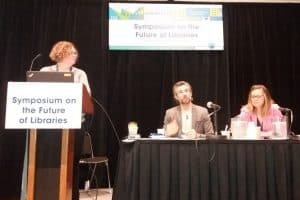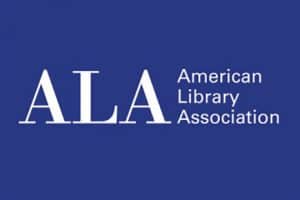
How are librarians centering activities around computational thinking for youth and families? What does coding look like in the library?
At “Libraries Ready to Code: From Research to Practice,” a Symposium on the Future of Libraries session at the American Library Association’s (ALA) 2018 Midwinter Meeting & Exhibits on Saturday, panelists involved with the Ready to Code (RtC) initiative shared stories of embedding computational thinking (CT), computer science, and coding into workshops and programs.
“Libraries do a ton around STEM and STEAM, but we didn’t have a sense of what libraries were doing underneath that,” said Marijke Visser, associate director at ALA’s Office for Information Technology Policy. “Coding is the vehicle to do computation thinking. … It’s a skill that’s transferable to whatever you’re interested in.”
RtC panelists spoke about CT activities that are “interest-powered,” as well as reflective of the other principles of Connected Learning: production-centered, peer-supported, shared purpose, academically oriented, and openly networked.
For Kristin Brumbach, high-school librarian at Governor Mifflin School District in Shillington, Pa., CT translated to Mifflin’s Feathered Friends, a citizen science project designed to connect K-12 students with nature and each other. The project aimed to bring technological solutions and “authentic production experience” to monitoring birds in a birdhouse.
Brumbach said the program was structured around the client-engineer relationship, with high-school students interviewing elementary-school students to get a sense of what products to create. “We took their ideas and shimmed them into three different categories: website, app, and motion-sensing camera,” she said.
At DC Public Library, children’s librarian Paula Langsam recognized that CT had a place with an even younger group. “When I saw computation thinking, I said, ‘Oh, this is early literacy,’” Langsam said. “[It’s] larger messy problems into smaller pieces. [It’s] pattern recognition, which is like book awareness.” Her Ready, Set, Think! program introduces families to CT skills through everyday activities that can be broken down into steps, such as tying shoelaces.
Juan Rubio, program manager for digital media and learning at Seattle Public Library, shared that teens in his community are given leadership roles while assisting with CT workshops, emphasizing the peer-centered principle. Rubio had some ideas for teen-led instruction—give students clear expectations, time to prepare, room to create meaningful relationships, and ongoing support.
For Joe Sanchez, assistant professor at Queens College CUNY, CT is used as a process to look at iterative design in his Design and Production of Multimedia class. “When you submit a project, you’re going to keep improving it,” he said, explaining how peer review and decomposition, though not often associated with art and humanities, is essential to instruction. “When it’s peer-to-peer [review], we try to erase those power structures.”
“Each of the panelists told a story,” said moderator Linda Braun, learning consultant at LEO and continuing education consultant for the Young Adult Library Services Association, at the close of the session. “Think about the work you are doing with your community. Where do you see opportunities to build in connected learning?”


